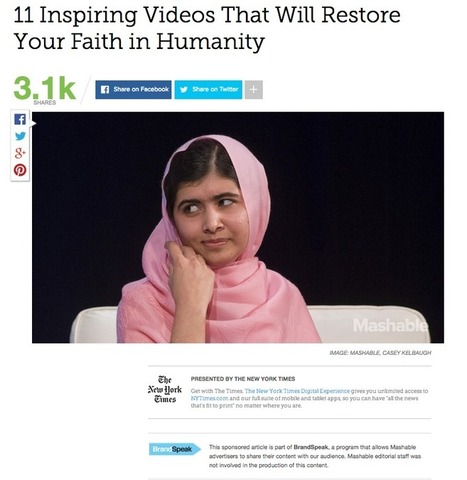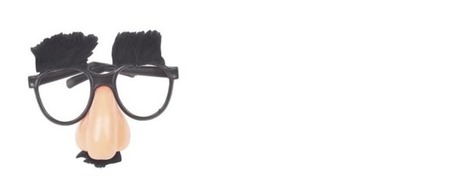 Your new post is loading...
 Your new post is loading...
Ten months ago, Dell debuted as The New York Times' first paid post partner.
Dell’s paid post went live in January to neutral reviews. We called it “solid, if unspectacular… the type of boilerplate story about the changing millennial workforce that nearly every brand seems to write.”
But now, the brand is back for a second go-round with a visually impressive exploration of enterprise cloud computing. Both Dell’s first posts and the new offering were written by journalists hired by The New York Times, but this one is enhanced with proprietary research on corporate security and interactive global market data....
...But while brand storytelling may be dominating the trade conference stages, it’s not enough on its own for brands aiming to add meaningful value to their customers over the long term.
Strategies for Retention: Own Every Consumer Touch Point
Most content marketers know this particular statistic: 70 percent of consumers prefer getting to know a company via content over ads. To deliver this type of lasting, comprehensive value to their audiences, brands must build their content strategy around three core areas of focus: Foundational content Engagement content Social content...
...Spark and its sibling branded content and entertainment division LiquidThread and Genworth are launching an integrated partnership with CNN that makes Genworth the first advertiser to use CNN’s Content Development Studio, a unit under the network that works with advertisers and agencies to develop branded entertainment and sponsored programming.
Under the deal, Spark worked with the CNN production team to develop new informational brand creative -- both :15 and :60 second versions -- to convey the importance of planning for the future. "CNN was immensely collaborative and it is useful to use their voice to lend credibility to the conversation," says Levin.
At the same time, CNN is publishing a series of articles to educate Genworth's target Boomer audience about the importance of long-term care planning and best practices to prepare for their future. These articles will run on CNN's online channels as sponsored and organic content.....
It says something about our media culture that in a short time the term “native advertising” has gone from industry buzzword to pop culture punch line.
The two most memorable references come from HBO. On “Girls,” Lena Dunham’s Hannah takes—and soon leaves—a writing job in the sponsored content department at GQ. More recently on "Last Week Tonight," John Oliver delivers an entertaining riff about the profusion of “sponsored content” on news sites.
Oliver conceded that Netflix's native ad for the New York Times about female prison inmates, promoting the series "Orange Is the New Black," was “about as good as it gets.” This got us thinking about all the other noteworthy executions this year which demonstrate that sponsored content can indeed be good—nay, great—content. With that in mind, we asked some of the native advertising gurus here at HuffPost-AOL to name their picks for the most notable native or branded content campaigns of the year thus far, both from around the Web as well as in-house.
Here’s what we came up with, in alphabetical order by advertiser....
Those 11 inspiring videos are all original feel-good New York Times productions, and as Digiday’s Lucia Moses noted this morning, the ad is intended to drive subscription signups forThe Times, with a prominent call to action at the top of the piece imploring readers to “Get with The Times.
”While this may seem bizarre and a little too meta for this early in the morning, it’s actually a shrewd move by The Times to grow their audience. Clearly, they’ve identified Mashable readers as potential Times readers and subscribers, and as a result, they’ve come to them with a month-long campaign of branded posts._
The Times also punched up the titles of the individual videos for a Mashable audience. “Tattoo Artist Gives Breast Cancer Survivors Nipples and Hope” was originally titled “The Nipple Artist,” and “Can Your Grandma Pump Iron Like This?” was called “Shirley and the Bodybuilder.”...
Doug Scott’s recent departure from OgilvyEntertainment, the successful unit he founded eight years ago, has raised questions about whether its WPP parent might fold it into another corporate entertainment sibling like media agency Mindshare Entertainment or GroupM Entertainment at the operating level. While Ogilvy execs say that isn’t in the works, such speculation still begs the larger industry question: As media, creative and PR agencies—along with production companies—vie to lead the growing number of marketer content initiatives, where should responsibility for branded storytelling reside? With traditional advertising becoming less profitable, everyone, obviously, is scrambling for these new income sources.
On the creative agency front, proponents argue that without a great concept born from understanding a brand’s narrative, long-form storytelling doesn’t hold an audience’s attention and justify the media expense....
Eagle-eyed readers may notice a new feature here on Re/code today. It’s called “Sponsor Content,” and is, for us, a new form of advertising. Known broadly as “native advertising,” this is a category of ad that takes the form of an article written by, or commissioned by, an advertiser. It’s widely used online, but the technique actually goes back well before the Web, when print publications ran articles written by advertisers that were called “advertorials.”
Some websites might try to present these ads as if they were normal posts written by their reporters, editors, or curated guest contributors. We won’t be doing that. You’ll notice that we clearly label them “Sponsor Content” with a blue label instead of our usual black one. We also use the company logo next to the writer’s byline, and, at the bottom of each such post, include a disclosure statement saying that the article is a form of advertising, and was neither written by, nor edited by, our journalists.
That doesn’t mean these pieces are bad, or unworthy of your time. It doesn’t mean we are embarrassed to post them. In fact, we hope you will find them interesting. It just means we want to keep faith with you by making things clear.
It seems like everyone has something controversial to say about sponsored content these days, from John Oliver on HBO to even us here at Contently.Much of that controversy centers around two key questions: Is brand-backed content on publisher sites labeled well enough? And is it eroding the publishers’ editorial independence and reputation?
Now, a Google engineer has taken on this transparency and labeling challenge with a browser plug-in for Chrome and Firefox called AdDetector, that adds another layer of labeling to sponsored posts. It’s drumming up a fair amount of buzz in the media world already....
On Sunday's Last Week Tonight With Jon Oliver, the network took their commentary on the separation of business and journalism up a notch and completely annihilated sponsored content. Needless to say, it was hilarious.
...Oliver started off his rant by noting that he was lucky to work for advertisement-free HBO, where he is free to say that “Old Navy makes you look like a tacky murderer.” After that, Oliver delivered 11 full minutes of pinpoint jokes about native ads. Few escaped the fire, with The New York Times‘ Meredith Levien, TIME Inc. CEO Joseph Ripp, and BuzzFeed co-founder Jonah Peretti on the receiving end of Last Week Tonight’s hottest burns....
...As noted above, publishers’ widespread assumption that they’re communicating clearly and transparently when they label a post as “sponsored content” may not be true.
When asked what they think a “sponsored content” label means when they see it on a news website, the answers varied greatly.
Ultimately, this shouldn’t come as much of a surprise; the term “sponsored content” means different things not only among different publishers, but also within the framework of a single publisher. For instance, Mashable runs two different types of sponsored content—one model where a brand merely underwrites a piece of Mashable editorial and has no influence on its content, and a separate model where they feature content created by the brand. z
And while the content of The New York Times’ inaugural “paid post” campaign was created by Dell, their recent paid-post longform piece for Orange is the New Black, “Women Inmates: Why The Male Model Doesn’t Work,” was written by Melanie Deziel, an editor at the Times‘ brand studio....
As more and more brands dive in to native advertising, the question remains: are these ads actually profitable for brands?
Examples of these native ads run from the advertorial to sponsored content to interstitial ads on mobile phone apps. And options are multiplying. As is the money spent.
The question brands must ask (even though there is no simple answer) is: are we getting a positive return on the dollars being spent on native advertising?I asked a few players in the space what they thought....
Content marketing is not just a growing trend — it’s a growing necessity to succeed in today’s marketplace. With over 70 percent of marketers increasing their budget on content this year, it’s imperative that they understand content marketing best practices before diving in too quickly. The following infographic includes tips & tactics from 14 experts taken from recent content marketing events; intended to help you adjust your current content strategy to add value, drive engagement and increase leads.
Native advertising is paid content that matches a publication’s editorial standards while meeting the audience’s expectations.
Think Captain Morgan’s campaign on BuzzFeed in general, their 15 Things You Didn’t Know About 15 Captains, Commanders And Conquerors article in particular.
First off, the theme of the article matches the brand’s values: Captain Morgan was a real live pirate who thrived on adventure and raw conquest — a theme not too foreign to BuzzFeed readers.
Moreover, the article matches the editorial standards of BuzzFeed: a list with big images and short, quirky copy — a format their audience expects....
|
Native is one of the hottest topics in digital media, and advertisers and publishers are taking notice.
By creating advertisements that are in the same format as the content audiences are there to consume, marketers hope to provide a much less disruptive advertising experience. Native ads have also proven effective, drawing higher click rates than traditional banner ads, particularly on mobile devices.
New and exclusive data from BI Intelligence finds that spending on native ads will reach $7.9 billion this year and grow to $21 billion in 2018, rising from just $4.7 billion in 2013. We are the only research service that has provided a detailed breakdown of spend projections and growth rates for each of the three main native ad types — social-native, native-style display ads, and sponsored content. ...
There are two important parts of delivering a message: the delivery and the message. If one is a dud, it doesn’t matter how good the other one is.
You wouldn’t read a story if it was printed underneath a bus, and the most atrocious film in the world is still a car-crash if played on an IMAX cinema. The same applies to your brand storytelling, you can have the most heartwarming and engaging campaign in the world, but if it’s not delivered effectively your time and money has been wasted.
You wouldn’t want to spend months creating an incredible story only for nobody to hear it, would you? Every day there are brands who do this by not thinking carefully about how to present their message to their audience. An intelligent delivery strategy will make it easier for people to hear the story you want to tell, optimizing your chances of turning them into customers. Here’s how to ensure that the story your brand is telling doesn’t get missed...
Can Google Glass help cross cultural boundaries and even save lives? It can in "Captions," a 4-minute short film promoting a translation app currently in development.
Writer, director and editor Joe Sill of digital studio Everdream Pictures describes the cinematic clip as a "branded content spec ad," much like the team's earlier, unofficial Tesla spot, "Modern Spaceship," whose admirers included even Tesla CEO Elon Musk.
And sure enough, the new video has also gotten some top-level corporate love, with the official Google Glass page giving it a share on Facebook.
Sam Morrill, senior curator at Vimeo, also left a comment on the clip: "Interesting film. Really sharp look."
"Captions" focuses on a Glass translation app that helps a photographer in the Mexican desert communicate with a boy who's been bitten by a snake....
Getting major media placements in outlets such as "NBC Nightly News" and The Huffington Post is every PR and media relations professional's dream—and if you can get 1 million or so people to visit your brand's website in response to the coverage, that's icing on the cake.
This year, The Ohio State University Wexner Medical Center pulled off this feat using a brand journalism approach. Here's how it attracted so much public attention to the news so quickly....
A population of 100,000 is no longer a guarantee that a city like Richmond, California can sustain a thriving daily paper. Readers have drifted from the tactile pleasures of print to the digital gratification of their smartphone screens, and advertising revenues have drifted with them. Titles that once served up debates from City Hall, news of school teams’ triumphs and classified ads for outgrown bikes have stopped the presses for good.
Last January, however, a site called the Richmond Standard launched, promising “a community-driven daily news source dedicated to shining a light on the positive things that are going on in the community”, and giving everyone from athletes to entrepreneurs the recognition they deserve. Since then, it has recorded the “quick-thinking teen” commended by California’s governor for saving a woman from overdosing; the “incredible strength” of the 5ft 6in high-school freshman who can bench-press “a whopping 295lbs”; and councilman Tom Butt’s warning about the costs of vacating a blighted public housing project.
The Richmond Standard is one of the more polished sites to emerge in the age of hyper-local digital news brands such as Patch and DNAinfo.com. That may be because it is run and funded by Chevron, the $240bn oil group which owns the Richmond refinery that in August 2012 caught fire, spewing plumes of black smoke over the city and sending more than 15,000 residents to hospital for medical help....
At a time when good-paying freelance assignments are harder to come by, many journalists are heeding the call of native advertising, where the pay is decent and the work is steady. But there’s a cost. Many worry about the impact on their credibility as a journalist. Some are even finding they aren’t so welcome back in newsrooms once they work for the business side.
In the latest in Digiday’s “Confessions” series, we talked to a veteran freelance writer who has written for top women’s magazines and other national publications about the dark side of native. In this case, the journalist was working for a publisher’s content studio, which assigned stories a given client wanted written....
...I don’t know if the guy owned stock in Second Life, or was shacking up with the founder’s daughter, or if his Second Life avatar owned the biggest fake ad agency in that big fake world and he planned to corner the Second Life fake ad market.
All I know is that he made it clear. Laid it bare. If we weren’t building campaigns to include a serious presence on Second Life, we were doomed. DOOMED!And so today, whenever I hear someone declare that the future of digital advertising is native ads, all I hear is Second Life. And all I smell is poo....
Online advertising has grown exponentially since its foundation in the 90s. Now, online ad sales make up the majority of the industry, and savvy companies are directing the lion’s share of their budgets at the digital space.
Advertising through social media is nothing new, but so far, brands have been playing it safe, using many of the same methods that have already been successful in the past – combining banner- and text-link-style ads in news feeds and sidebars. But the possibilities of social advertising have yet to be fully explored.
The real power comes not from the reach of a company’s network, but from getting that company’s customers to do the outreach FOR them.
Social media is changing the way people view and interact with content online. While the idea of a website “page” has been a vital component in the way people understand the web, the use of feed-based content in Facebook, Twitter and Instagram has changed the concept of what a website IS. ....
In one of the largest studies of people's attitudes towards native advertising, 62 percent said that it didn't help to enhance the reputation of news sites, but brands were seen to benefit from appearing on highly trusted media sites.
Native advertising is a form of advertising designed to look similar to "native" media content such as news or feature articles written by journalists.
The study shows that media companies carry a far higher risk to their reputation and value perception in allowing native advertising than their brand advertisers. However, native advertising on business news, and entertainment news sites, was less problematic than on general news sites....
As large companies look for creative ways to draw attention to their advertising on content sites, a number of Fortune 500 firms are going in the opposite direction. Instead of putting their advertising around articles created by news firms, they’re putting news articles around their promotions. From technology to fashion and from finance to food and drink, businesses are building hubs that allow them to control both content and advertising.
The content hubs look, on first appearance, like any traditional news site. Large headlines and lead stories point out the most important features of the day. Sections often lead to categories within the site while scrolling down the page brings up more stories and articles.
In terms of design the sites haven’t broken new ground; they’ve followed formulas laid out by traditional news firms like CNN and Fox, as well as online news companies like Mashable and Buzzfeed. Copying the design immediately gives them an appearance of objective news gathering rather than a sense of commercial promotion...
...As the traditional journalism business continues to implode, journalism educators need to be thinking a lot more about the second category, but also in broader ways about the first. If we recognize journalism in places where we never used to acknowledge its existence, journalism programs will discover niches that could fuel new programs and attract new students.
Here’s one: In 2009, I suggested that some advocacy organizations were creating “almost-journalism” — doing deep and valuable reporting on issues that mattered, such as civil liberties, human rights and more. They could do even better, I said, if they applied basic journalistic principles — because they’d be even more credible.
Hill+Knowltons Group SJR doesnt make branded content. It makes publications that you might not even realize come from company marketing budgets.
Thanks to the Internet, anyone can now be a publisher.
Which is kind of like saying that anyone in a crowded football stadium could stand and deliver an eloquent speech. The hard part is not making noise. The hard part is getting people to listen. So by most aspiring publications’ definitions of success, a technology blog called the Txchnologist has made it. Last year, its articles were picked up about 200 times, including in Time, Smithsonian magazine, and on MSN News.
You may have seen its coverage of temporary tattoos that could make electric telekinesis possible. Or eyewear that could help people with red-green color blindness.
But what you may not have noticed, unless you read all the way to the bottom of an article or navigated to the blog’s homepage, is that the entire production comes out of GE’s marketing budget. It’s been created by a branch of PR firm Hill+Knowlton called Group SJR....
|



 Your new post is loading...
Your new post is loading...






































Content marketing or brand journalism continues to evolve as this New York Times effort with Dell demonstrates.